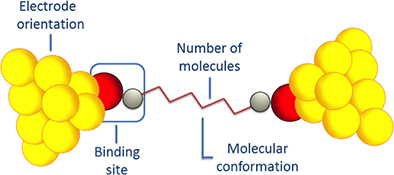
Australian Journal of Chemistry
Volume 69 Number 3 2016
CH15634Molecular Electronics: History and Fundamentals

In this Primer Review, we introduce the topic of molecular electronics, drawing on some of the earliest expressions of the fundamental concepts, and summarizing key concepts to provide the interested reader with an entry to this fascinating field of science and emerging technology.
CH15275Kinetic Studies of Gold Recovery from Diluted Chloride Aqueous Solutions Using Activated Carbon Organosorb 10 CO

Scanning electron microscopy images of the activated carbon surface after adsorption process are shown. The external surface of the porous material was covered by the metallic particles. A random distribution of the metallic particles inside the activated carbon pores was observed.
CH15271Activation Volumes for the Hydration Reactions of Carbon Dioxide

The reactions of CO2 in aqueous solutions are among the most fundamental reactions relevant to the chemical environment. Investigation of the kinetic reactions for CO2 hydration accompanied by systematic changes in pressure can be utilised to probe the corresponding activation volume profiles and transition states for CO2 hydration via the spontaneous and alkaline pathways.
CH15329Solid–Liquid Reaction Synthesis of High-Purity Potassium Hexathionate and Its Antibacterial Properties

High-purity potassium hexathionate, with effective antibacterial and bactericidal activities, was prepared through a convenient process from sodium thiosulfate (solid) and disulfur dichloride.
CH15204Synthesis and Characterization of a New Group of Exo-Coordinating O2N2-Donor Macrocycles

We show the synthetic route of O2N2-donor macrocycles mounted with 1,3-diazacyclohexane subrings, which could aid in the production of neuronal blocking drugs or the manufacture of high-energy materials.
CH15344Synthetic, Spectroscopic, Crystallographic, and Biological Studies of Seven-Coordinated Diorganotin(IV) Complexes Derived from Schiff Bases and Pyridinic Carboxylic Acids

The synthesis of seven-coordinated diorganotin(iv) monomeric derivatives is reported. All complexes were elucidated by mass spectrometry, IR, multinuclear NMR, and elemental analyses. The complexes 5a, 5d, 5e, 5g, and 6a were also confirmed by X-ray crystallography diffraction analyses. The antioxidant activity and the anti-inflammatory 12-O-tetradecanoylphorbol-13-acetate assays were evaluated.
CH15071Aryl Naphthoates: A Conformational Analysis Supported by Single-Crystal X-Ray Diffraction

The solid state conformations of 12 title compounds as determined by X-ray diffraction were described in terms of co-planarity, intramolecular steric interference, and crystal packing effects. The configuration of the molecules adopted in the crystal was interpreted with the assistance of theoretical calculations and the observed C=O stretching vibrations.
CH15177Electronic Structure Change in DNA Caused by Base Pair Motions and Its Effect on Charge Transfer in DNA Chains

By utilizing a pseudo-helical base pair stack model, we systematically studied the electronic structure of DNA and its dependence on geometry changes that represent the important DNA motions, including the translation, the twist and the torsion of the base pairs. Our calculations of the electronic structure under large geometry variation, including large base pair stacking deformation and the insertion of phenyl rings in the bases, can provide good guidelines for structural modifications of DNA.
CH15398Uncatalyzed CO2Li-Mediated SNAr Reaction of Unprotected Benzoic Acids via Silicon Trickery

The alkyl and aryllithium SNAr displacement of a fluoro or methoxy group from unprotected 2-fluoro/methoxybenzoic acids is discussed. It was discovered that a TMS group located at the C6-position ortho to the carboxyl group shields effectively the carboxylate against nucleophilic attack, thus reducing dramatically ketone formation, and reorients nucleophilic substitution to the C2-position.
CH15391Use of Modified γ-Alumina Nanoparticles for the Extraction and Preconcentration of Trace Amounts of Cadmium Ions

Nanometre-sized γ-alumina coated with sodium dodecyl sulfate–4-(2-pyridylazo)resorcinol was developed as a new sorbent towards the solid phase extraction for preconcentration of ultra-trace quantities of cadmium ions as a prior step to their determination by flame atomic absorption spectrometry.
CH15369A Density Functional Theory Investigation of the Tandem Radical Cyclization of 1-[2-Yl-3-(2-Methoxyphenyl)-prop-2-enyl]-6-oxo-1,6-dihydropyridine-2-carbonitrile

The DFT computation in this study demonstrates that the radical 3b can undergo 5-exo/6-endo cyclizations to provide the tetracyclic product 2b. The neophyl-like rearrangements into 2a and 2b′ are of minor importance. The related mechanism is estimated by the attack angles, attack orientations, and intrinsic reaction barriers.
CH15460Synthesis and Characterization of Bradykinin Derivatives Based on a β-Cyclodextrin Core

Our work provides evidence that the position of the bioactive peptide on cyclodextrin analogues is important for proliferation activity in tumour cells with applications in the delivery of cytotoxic drugs.
CH15413Synthesis, Structures, and Properties of Polynuclear Silver(I) Complexes Containing Tetra-Phosphine Ligand with Ag⋅⋅⋅C Interactions

Two silver(i) complexes, [Ag4(pbaa)(µ-κ1S,κ2S-Etdtc)4] (1) and [Ag4(pbaa)(µ-κ1S,κ2S-Etdtc)2(µ-κ1S,κ1S-Etdtc)2 ] (2), have been prepared and characterized.
CH15484Photocatalytic Degradation of Gaseous Formaldehyde by Modified Hierarchical TiO2 Nanotubes at Room Temperature

The CO2 transmittance peak height formed upon the photodegradation of formaldehyde fits a pseudo-first-order kinetic model by a linear transform equation. The Pt/TiO2 nanotube arrays showed the fastest degradation and highest gas phase photocatalytic (PC) activity. The enhanced PC activity can be ascribed to the formation of a Schottky junction between the noble metal nanoparticles and TiO2.
CH15293Novel Disulfide-Containing Poly(β-amino ester)-Functionalised Magnetic Nanoparticles for Efficient Gene Delivery

In this study, novel disulfide-containing poly(β-amino ester)s (SFs) were synthesised to subsequently combine with biocompatible magnetic nanoparticles (MNPs) via electrostatic interaction, leading to the formation of magnetic complexes for gene delivery. The transfection efficiency and cytotoxicity of the resulting magnetic gene complexes were investigated.
CH15431Microwave-Assisted Synthesis of Nitrogen-Doped Multi-Layer Graphene Quantum Dots with Oxygen-Rich Functional Groups

Strong green-luminescent nitrogen-doped graphene quantum dots (N-GQDs) were successfully prepared via a microwave-assisted hydrothermal method. The fabricated N-GQDs show a highly crystalline structure and a wavelength-dependent luminescence emission and possess an N/C atomic ratio and photoluminescence quantum yield of 5.7 % and 5.2 %, respectively.


